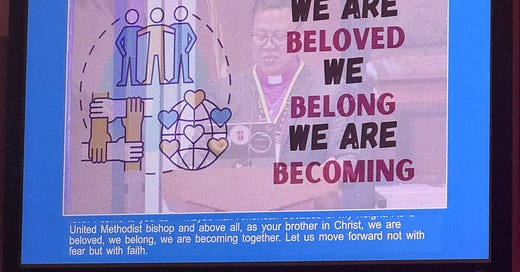I spent Thursday through Saturday at the annual conference for the Mountain Sky Conference of the United Methodist Church. Clergy and Laity gathered from Colorado, Wyoming, Montana, and Utah (plus one church in Salmon, Idaho) to hear messages, music, encouragement, and to vote on action items.
The good news is that it didn’t require overnight stays as we met in Highlands Ranch, Colorado. The bad news is that Highlands Ranch is about as far from our house as you can get and still be in the Denver metro area — commutes of nearly an hour each way.
There were 540 registered to attend in person and another hundred plus viewing online. It was the first annual conference led by Bishop Kristin Stoneking. Things ran smoothly and efficiently and we ended precisely at 12:15 on Saturday, just as the program promised!
This was the theme for the conference. The “Belong” reference had an extra meaning for our crowd as that’s the name of our congregation. There were lots of references to becoming — in the spirit of Wesley’s encouragement to “move on toward holiness”.
This theme has deeper connotations in light of the recent history of the United Methodist Church. Past strife over LGBTQIA2S1 affirmation. Prior to the 2024 General Conference, the Methodists split with the traditionalist segment disaffiliating and becoming the Global Methodist Church. Last year’s Annual Conference in Casper was the first one following the split.
Some of the business at Annual Conference followed up on work done by the 2020/2024 General Conference.2 There were four constitutional amendments passed at the meeting in Charlotte, but those must be ratified by 2/3 of all votes at the collected annual conferences. One of these focused on the Regionalization plan, separating world-wide Methodism into geographic segments that could manage their own ministries.3 A second expanded the inclusiveness of both membership and ministry, making clear that gender or ability are not barriers. The third reflected a commitment to racial justice, standing against white privilege and white supremacy in favor of antiracism. The fourth was a straightforward step to change descriptors for masters degrees as some countries don’t have a DMin equivalent. The results of these votes were not shared, as it is only the total vote that finally matters. However, given the lopsided nature of the votes that were reported out I’m sure that all four received overwhelming support.
As an embodiment of the regionalization plan, Bishop Israel Painit from the Davao Episcopal District in the Phillipines was our guest. He spoke of what it means to deal with diversity within his geographic area and his joy at being part of the larger UMC body.
Bishop Stoneking challenged us to take the next steps of becoming by being willing to address the very real issues of injustice, racism, and inequality. We are to become the moral witness that God has called us to be.
Some of the business was somewhat pedestrian. We heard of changes to the petition plan. We sadly voted on the closure of a number of congregations, including the one Belong has been sharing facilities with.
Tbere were some petitions that dealt with important topics of contemporary society. One was a resolution drawing attention to missing and murdered indigenous persons, especially women. Given the Mountain Sky’s historic connections to the Sand Creek Massacre, this was very meaningful. Another petition created an LGBTQIA2S committee within the conference to oversee related issues. There was also a petition denouncing the genocide in Gaza (which was the most contested of the petitions although it passed by over a 30% margin). The Bishops of the Western Jurisdiction released a video statement denouncing the immigration crackdowns in LA and elsewhere.
On both Friday and Saturday, we heard from church vitality consultant Linda Greenwood. She spoke on what’s next for the UMC, that we cannot go back. Drawing upon techniques used in vineyards, she spoke of Jesus’ imagery in John 15 and how important grafting is to take older vines and bring them new life. She unpacked four themes for congregations (and, by analogy, annual conferences and denominations). They were tending to grief, discerning purpose4, being a neighbor (not just loving neighbor), and expanding imagination.5 I may return to her work in a later SubStack as it not only relates to congregations and denominations, but has a lot to say about liberal arts universities.
On Saturday morning, we celebrated those clergy who were retiring. We heard video clips where they described their call to ministry (although some clips got cut short) following which they were invited to the platform. Then the new ordinands, who were ordained Saturday afternoon, were invited to stand in front of them. A long strand of ribbon was wrapped around both the retirees and the ordinands as they were surrounded in prayer.
It was a physical representation of being Beloved, of Belonging to something larger than yourself, and being excited about what we are Becoming.
Next year in Billings!
Learned about the 2S part at the conference. It’s a reference to Native American “two-spirit” identity, where gender isn’t an clear concept. This was also evident at a recent Denver Art Museum exhibit by Kent Monkman.
It was scheduled for 2020 but disrupted by Covid. When it finally happened in 20204, it now carries both dates.
Nearly 30 years ago I was part of a similar conversation in the Church of the Nazarene. While the CON did regionalize, there is still a strong sense of US control. I hope the UMC learns that lesson and leans into trusting their worldwide partners.
She described an exercise in which congregations are asked to select a biblical story that reflects their path. Most choose wondering in the wilderness. I was reminded a similar method I heard about decades ago from anthropologist James Hopewell.
Which made me think immediately of Walter Brueggeman, who recently passed.




